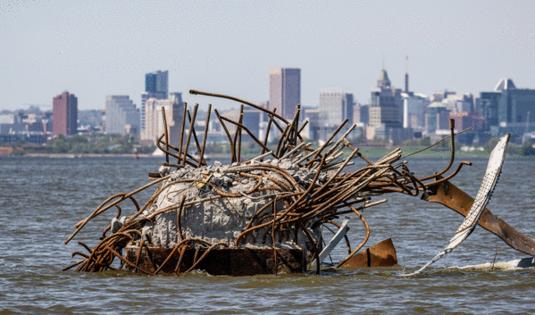US-required bridge inspections don't test for ship strike. Then, one hit the Key Bridge
Published in News & Features
BALTIMORE — When the Francis Scott Key Bridge was inspected in May 2021, it earned high marks.
Its railings and guardrails met modern standards. Its foundations were “stable” and didn’t show signs of erosion at the riverbed. The protection around its piers was “functioning,” the best grade in that category.
It wasn’t, however, assessed for its ability to withstand a collision from a vessel.
A collision came, though. In the early hours of March 26, a massive cargo ship — much larger than the average ship when the bridge was built in 1976 — crashed into one of the bridge’s vital supports. The impact sent those railings, guardrails and roughly 50,000 tons of steel and concrete tumbling into the Patapsco River. The catastrophe killed six men fixing potholes on the bridge, launched arduous efforts to clean up what could be the costliest maritime accident ever and prompted an already litigious fight over who will foot the bill. The National Transportation and Safety Board is investigating the incident with a focus on the ship’s electrical system and the FBI is conducting a criminal probe.
Bridge inspections are typically completed by the bridge owner or one of its contractors, then the owner provides the data to the federal government. The Key Bridge’s 2021 inspection is the most recent included in the Federal Highway Administration’s National Bridge Inventory.
Although protection from a ship strike is considered when any bridge is constructed today, there are no federal statutes, regulations or policies that require existing bridges be evaluated for the possibility of a vessel collision. Whether to do so is left to the judgment of each bridge’s owner, the Federal Highway Administration told The Baltimore Sun.
Some bridge owners elsewhere — including ones in California, Delaware and New York — say they already do that.
Asked whether the Key Bridge or the Chesapeake Bay Bridge were ever evaluated for vessel collision, the bridges’ owner, the Maryland Transportation Authority, offered a statement instead of an answer: “Our asset management program continually prioritizes asset needs based on age, condition, criticality and risk. We will continue to evaluate the condition of bridges as well as their risks as part of our well-established nationally recognized programs.”
The authority said that “with the Key Bridge incident in mind, there has been a renewed focus on pier protection” of its bridges and it will consider any recommendations made by the NTSB.
But that agency’s final report could take up to two years. NTSB Chair Jennifer Homendy told members of Congress earlier this month that evaluating “pier protection” is something that bridge owners can do now.
...continued
©2024 The Baltimore Sun. Visit at baltimoresun.com. Distributed by Tribune Content Agency, LLC.







Comments